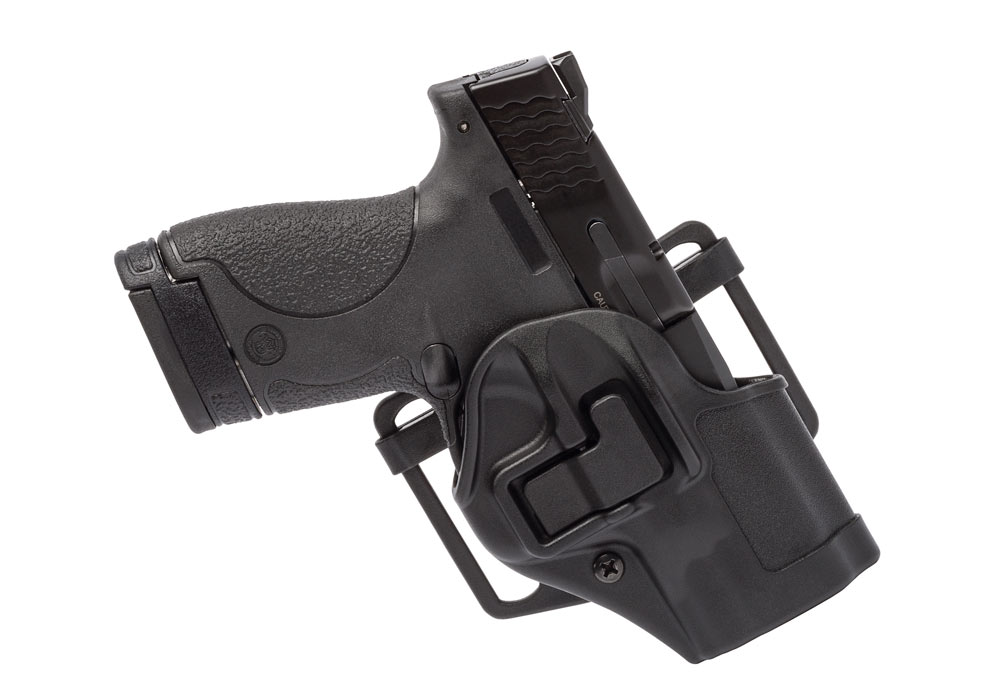At GunDigest, we independently review products. However, we may earn a commission when you purchase through links on our site. Learn More
Understanding Holster Retention

Holster retention is an important concept to grasp, whether you open or concealed carry. Here is a look at some general concepts on holster retention.
Friction
Leather scabbards have the innate ability to retain the handgun by good ol’ fashioned friction. Passive retention, as it’s sometimes called, is enhanced by the scabbard being molded to your make and model of gun, which increases contact across the gun’s exterior surface areas. If a leather holster is rough side in, that helps too.
Leather holsters achieve optimum retention immediately after the break-in period and, assuming the leather is of high quality, remain good for many years with occasional leather treatment. Avoid gimmicks like sticking your holster in water, or a warm oven, to adjust fit. These are more apt to ruin your good leather than help it. Not to mention making your kitchen stink like a glue factory.
Kydex, or polymer holsters aren’t affected by moisture, but also don’t naturally grip the handgun without some help from tension screws. By tightening or loosening these screws you can get just the right amount of friction for a basic level of security. The trouble is keeping the screws from loosening up throughout the day.
One Mechanism
One way to define a Level 2 retention holster is one which employs the same friction-based grip as Level 1, but with the addition of an active mechanical element, such as a hood, back strap, finger- or thumb-operated lever. Some believe that active-retention systems are only needed for open carry holsters — holsters used by armed citizens open carrying or on-duty law enforcement officers.
A gun grab, they say, isn’t likely if your gun is concealed. Others disagree. “People who haven’t learned to properly activate retention devices call them ‘suicide straps,’” writes Massad Ayoob in the Gun Digest Book of Concealed Carry, 2nd Edition. “They will tell you, ‘It’s concealed, so you don’t have to worry about someone grabbing it.’ Rubbish! Your attacker may know from previous contact with you that you carry a pistol, and even where you carry it. He may have spotted it when scoping you out. Or you might get into a fight and the other guy wraps his arms around your waist for a bear hug or throw and feels the gun, at which time the fight for the pistol is on.”
Two Mechanisms
By adding a second active element to a holster, plus passing the tension or friction test of Level 1 security, you get to Level 3 retention. Examples include Blackhawk’s Level 3 rig, which features a push-button activated hood shroud to shield the handgun from a grab attempt coming from the front or back. This level is almost never used for concealed carry as the doohickeys just make the thing too big and bulky for mere mortals to hide well. It is, however, used by law officers and open carry advocates, where the gun is exposed.
Three Mechanisms
A Level 4 holster takes these security measures one-step further, but it’s safe to say such rigs aren’t recommended for the armed citizen. If you need a level 4 holster you’re going into some serious stuff beyond the realm of what this little book can reasonably cover and certainly outside the purview of everyday carry for ordinary citizens.
Editor's Note: This article is an excerpt from The Comprehensive Guide to Concealed Carry Holsters.
Editor's Note: This post has been updated from its original version on 9/24/2014.
Out of the Holster: Top CCW Insights Revealed
- Concealed Carry Holsters for Women
- Best Concealed Carry Holster
- Best Pocket Holster – Options For Easy Everyday Carry
- Concealed Carry Shoulder Holsters – Best Up-Top Carry Options
- AIWB vs IWB Holster – Pros & Cons
- Concealed Carry Fanny Pack – Pros & Cons for Everyday Use
Next Step: Get your FREE Printable Target Pack
Enhance your shooting precision with our 62 MOA Targets, perfect for rifles and handguns. Crafted in collaboration with Storm Tactical for accuracy and versatility.
Subscribe to the Gun Digest email newsletter and get your downloadable target pack sent straight to your inbox. Stay updated with the latest firearms info in the industry.